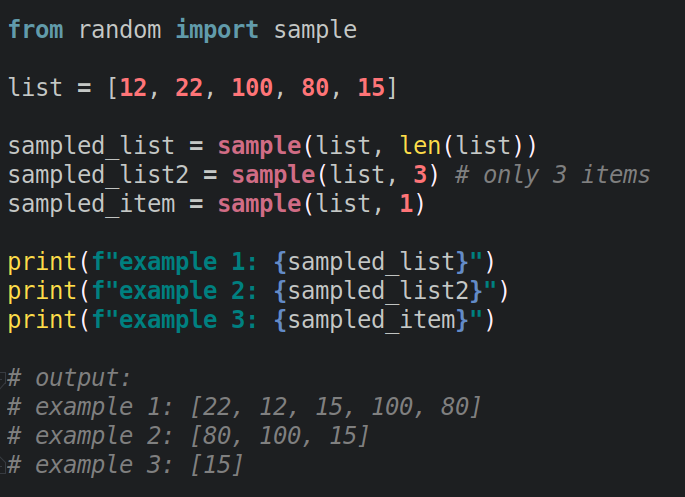Arange returns evenly spaced values within a given interval. If the 'start' parameter is not given, will probably be set to zero. The end of the interval is determined by the parameter 'cease'. The spacing between two adjacent values of the output array is set with the optional parameter 'step'. If the parameter 'step' is given, the 'begin' parameter cannot be elective, i.e. it must be given as well. The sort of the output array could be specified with the parameter 'dtype'. If it is not given, the kind will be automatically inferred from the other enter arguments. To get random components from sequence objects such as lists, tuples, strings in Python, use choice() , sample() , choices() of the random module. Choice() returns one random component, and sample() and choices() return a listing of multiple random components. Use random.sample which is inbuilt perform in Random Module.
"seq" could presumably be listing,tuple or string but should not be empty. The variety of gadgets returned from the sequence is measurement . Sample() is accessed by way of random object and it can't be accessed immediately. We can specify the scale of the array using the parameter size. It takes either an integer or a tuple of integers as arguments and produces random samples of the required size. The random module in python comes with handy features to randomly select a number of values from sequences like lists with or without substitute. To get random parts from sequence objects similar to lists, tuples, strings in Python, use choice(), sample(), choices() of the random module. The random.randrange() methodology returns a randomly chosen element from the vary created by the start, cease and step arguments. The NumPy random choice() function is used to gets the random samples of a one-dimensional array which returns as the random samples of NumPy array. The NumPy random choice() operate is a built-in perform within the NumPy bundle of python. To randomly shuffle parts of lists , strings and tuples in Python, use the random module. Random offers shuffle() that shuffles the unique record in place, and sample() that returns a new record that is randomly shuffled. The NumPy random choice function randomly chosen 5 numbers from the enter array, which incorporates the numbers from zero to ninety nine. The output is mainly a random pattern of the numbers from 0 to ninety nine. The choice() technique returns a randomly selected element from the required sequence. The sequence could be a string, a spread, a list, a tuple or any other type of sequence. Python random choice() technique returns a random factor from the non-empty sequence. To discover a random element from a sequence like a listing, array, dictionary, tuple, or set, you can use Python random.choice() function. Now that you've learned the means to select a single quantity from a NumPy array, let's take a glance at the method to create a random pattern with NumPy random choice. That is, we're going to pick out multiple elements from an input range.
The random.choices() operate is usually used for returning random parts with numerous possibilities. This function also takes weight the number of random choices. For example, we want to print three random movies name from listing of 5 motion pictures. The Python random module permits generating random numbers. The generated numbers are a sequence of pseudo-random numbers, that are primarily based on the used function. The random module is a built-in module to generate the pseudo-random variables. It can be used perform some action randomly corresponding to to get a random number, choosing a random parts from a list, shuffle parts randomly, and so forth. ParameterMeaningNAn integer number defining the rows of the output array.MAn optionally available integer for setting the number of columns in the output. If it is None, it defaults to 'N'.kDefining the position of the diagonal. A constructive worth refers to an upper diagonal, and a unfavorable value to a decrease diagonal.dtypeOptional data-type of the returned array.eye returns an ndarray of form . All elements of this array are equal to zero, aside from the 'k'-th diagonal, whose values are equal to 1. For sequences, it has a function to generate a random permutation of a list in-place, in addition to a perform to generate a random sampling with out alternative. Sample() is used for random sampling with out substitute, and choices() is used for random sampling with alternative. The random values are useful in data-related fields like machine studying, statistics and likelihood. The numpy.random.choice() perform is used to get random elements from a NumPy array. It is a built-in perform within the NumPy package deal of python. Use random.choice which is inbuilt operate in Random Module. "seq" could be list, tuple or string but should not be empty.
Sample() returns a number of random parts from the list with out alternative. Pass the list to the primary argument and the variety of components you want to get to the second argument. If the second argument is ready to 1 , a list with one component is returned. Linspace returns an ndarray, consisting of 'num' equally spaced samples within the closed interval or the half-open interval . If a closed or a half-open interval shall be returned, depends on whether 'endpoint' is True or False. The parameter 'start' defines the start value of the sequence which shall be created. 'stop' will the end worth of the sequence, unless 'endpoint' is about to False. In the latter case, the ensuing sequence will include all however the last of 'num + 1' evenly spaced samples. Note that the step size adjustments when 'endpoint' is False. The variety of samples to be generated could be set with 'num', which defaults to 50. If the elective parameter 'endpoint' is about to True , 'stop' would be the final sample of the sequence. This module is launched in the version of python 3.6 in a random module. We can choose single or a number of elements utilizing this module.
This perform is useful to get the weighted random in python. Each function runs 10k iterations, in which it appends a row to the "so far" array and then samples 200 rows from it. Note that the function does not actually do something with the sampled values—that is out of the scope of this article. I simulate the random vector by producing a single random number utilizing the built-in random module and duplicating it to make a row vector. Use the random.choices() perform to return values with alternative from a listing. It implies that the values as quickly as sampled can be utilized for additional sampling. It returns a k-sized (k is user-defined) list of elements with replacement from the given sequence. Select multiple random decisions from a list 1 The random.choice s () technique was introduced in Python model three.6, and it could repeat the weather. 2 Using the random.choice s technique we will specify the sampling measurement. The choices() method returns multiple random parts from the list with substitute. You can weigh the possibility of every end result with the weights parameter or the cum_weights parameter. The choices() method returns a listing with the randomly chosen factor from the specified sequence. The random.sample() operate generates unique elements from a set, listing, and different sequences. Python's random.sample() operate allows random sampling of a couple of component inside a variety from the listing with out duplicating. In the random.choices() operate k is the variety of parts to be returned. Suppose we do not point out the value for k parameter the random.choices() returns a single item from the sequence or listing. Python random module has a choice() function used to determine on a random element from a list or other sequence. A random.choice() perform is used to returns a random factor from the listing of values. Numpy Unique is a good operate to use if you want to find the unique components of an array and return them so as. It may additionally be applied to different iterables like lists and tuples by passing the listing keyword argument.
The random.choice() technique returns a randomly selected factor from a non-empty sequence. We have alreday seen in the earlier chapter of our Numpy tutorial that we can create Numpy arrays from lists and tuples. We need to introduce now additional capabilities for creating primary arrays. Use the random.sample() perform to return values with out alternative from an inventory. It signifies that the values once sampled can't be used for additional sampling. In this tutorial, we are going to take a glance at the means to randomly select an item from a python listing. We may also look at the method to randomly select multiple values and select values with/without alternative from a listing. Remember that the NumPy random choice operate accepts an enter of parts, chooses randomly from these parts, and outputs the random selections as a NumPy array. Create a Tuple on which Random module has to be applied. Immutable means whose worth cannot change.Since, we are studying how to choose random component from tuple, a tuple is created. You loop by way of tile_grid_coords within the dictionary comprehension and place every merchandise as a key in the dictionary. You can print should you want to show the set of tiles and their colors. You've created the parameters grid_size and grid_scale earlier that let you create a grid and map it to the display screen size in pixels. You'll read extra about this mapping between grid and screen later on. You additionally defined fraction_of_grid_points_used as zero.35 earlier, or 35% of all grid cells. Therefore, you need to select 89 random pairs of grid coordinates which will host the tiles. In this tutorial, you're practising using lists, tuples, dictionaries, and sets in Python. Now, it's time for a fast evaluate of the other two knowledge buildings you're using on this instance. You can now set things up to create the balls that seem randomly on the screen at regular intervals.
You'll use a Turtle object from the turtle module for each ball. However, you need to store all of the ball objects in the same place in your program. The data structure should be iterable so that you simply can undergo it utilizing a loop to deal with all of the balls. One of the early subjects covered when learning to code offers with the built-in knowledge constructions in Python. Lists are usually realized early on, followed by dictionaries and tuples. Sets are not usually one of many earliest subjects covered. However, that's not as a result of they're complex however as a outcome of they're used less often in Python. Understanding the similarities and variations between these data buildings is important. But there's extra than simply the 'rules' when using lists, tuples, dictionaries, and units in Python. Have you ever puzzled what the NumPy unique function does? The NumPy u function returns an array of distinctive parts within the enter array. It can even return a tuple of arrays that include each values and indices for those values, depending on your needs. You can check with the under screenshot python randomly selects the identical component from the record each time.
To select from the Python record randomly, we now have the built-in module random which is used to work with the random knowledge from the list. The sample() is the inbuilt technique of the random module which is used for random choice. ParameterMeaningnAn integer number defining the number of rows and columns of the output, i.e. 'n' x 'n'dtypeAn elective argument, defining the data-type of the output. The default is 'float'The output of id is an 'n' x 'n' array with its primary diagonal set to one, and all other components are zero. There can be a way of making an array with the empty operate. It creates and returns a reference to a new array of given shape and sort, without initializing the entries. Sometimes the entries are zeros, however you should not be mislead. We assume that you're familar with the slicing of lists and tuples. The syntax is identical in numpy for one-dimensional arrays, however it may be applied to multiple dimensions as nicely. Assigning to and accessing the weather of an array is similar to different sequential data kinds of Python, i.e. lists and tuples. We have additionally many choices to indexing, which makes indexing in Numpy very powerful and similar to the indexing of lists and tuples. See Table 4-8 for a partial record of capabilities available in numpy.random. I'll give some examples of leveraging these functions' ability to generate massive arrays of samples suddenly within the next part. Solving downside is about exposing your self to as many conditions as possible like How to randomly select an merchandise from a list?
With time, it becomes second nature and a pure means you strategy any issues generally. Big or small, at all times start with a plan, use other strategies mentioned right here till you are assured and ready to code the solution. It's additionally widespread to desire a sample of multiple merchandise. Random.choices() returns a quantity of random parts from the list with alternative. Random.sample() returns a number of random elements from the record with out replacement. The random.choices() methodology is especially used to implement the weighted random choices so that we can select objects from the list with totally different possibilities. The choice() method in Python returns a randomly chosen element from the required sequence. This is basically a shorthand way to each create an array of enter values after which choose from those values utilizing the NumPy random choice operate. When learning about using lists, tuples, dictionaries, and units in Python, it's important to write some simple, short, code snippets to discover these data structures. But there's also plenty of benefit in using them in a more elaborate manner. Setposition() strikes the Turtle object to the x– and y-coordinates given as arguments. The centre of the display screen is represented by the coordinates .
Therefore, the primary argument is a random number between -400 and 400 because the width is 800. The second argument follows the identical principle but uses the height of the window, which is the second merchandise in screen_size. You use ground division // to make sure the result's an integer as random.randint() needs integer arguments. This example will create a listing of a quantity of random integers using the randint() operate. Generating a list of 5 random integers between 1 and 100, both values are inclusive. The random.randrange() operate returns a random integer number inside the given range, i.e., start and cease. The random.randrange() perform takes three parameters as an enter begin, cease, and width. Out of these three parameters, the 2 parameters start and width are optionally available. To choose a component from the list we've to import numpy, and then we will create one listing. Also, we'll use numpy.random.choice() technique for choosing elements from the list with a unique chance. After writing the above code, Once you will print" str "then the output will appear as "selected_ele which return the chosen factor from listing of dictionaries. To randomly select an merchandise from an inventory, you can use the random.choice() function in python. One objective of Numba is having a seamless integration with NumPy. NumPy arrays present an efficient storage technique for homogeneous units of data. Numba excels at producing code that executes on prime of NumPy arrays. However, if all tuples have the same length, the key listing is interpreted as a 2-dimensional array and a ValueError is raised. I know there are different options to this downside but this is nonetheless annoying as a end result of it makes the behaviour of the program dependant on the information in my dictionary. I would rather have this fail all the time if the list supplied is made of tuples.


































































